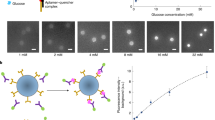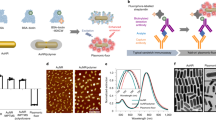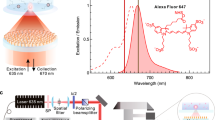Abstract
Bioaffinity binding assays such as the immunoassay are widely used in life science research. In an immunoassay, specific antibodies are used to bind target molecules in the sample, and quantification of the binding reaction reveals the amount of the target molecules. Here we present a method to measure bioaffinity assays using the two-photon excitation of fluorescence. In this method, microparticles are used as solid phase in binding the target molecules. The degree of binding is then quantified from individual microparticles by use of two photon excitation of fluorescence. We demonstrated the effectiveness of the method using the human α-fetoprotein (AFP) immunoassay, which is used to detect fetal disorders. The sensitivity and dynamic range we obtained with this assay indicate that this method can provide a cost-effective and simple way to measure various biomolecules in solution for research and clinical applications.
This is a preview of subscription content, access via your institution
Access options
Subscribe to this journal
Receive 12 print issues and online access
$209.00 per year
only $17.42 per issue
Buy this article
- Purchase on Springer Link
- Instant access to full article PDF
Prices may be subject to local taxes which are calculated during checkout




Similar content being viewed by others
References
Wittwer, C.T., Fillmore, G.C. & Garling, D.J. Minimizing the time required for DNA amplification by efficient heat transfer to small samples. Anal. Biochem. 186, 328–331 (1990).
Blackburn, G.F. et al. Electroluminescence detection for development of immunoassay and DNA probe assays for clinical diagnosis. Clin. Chem. 37, 1534–1539 (1991).
Siitari H., Hemmilä, I., Soini, E., Lövgren T. & Koistinen, V. Detection of HBsAg using time-resolved fluoroimmunoassay. Nature 301, 258–260 (1983).
Ekins, R.P. & Chu, F.W. Multianalyte microspot immunoassay—microanalytical “compact disk” of the future. Clin. Chem. 37, 1955–1967 (1991).
Swartzman, E.E., Miraglia, S.J., Mellentin-Michelotti, J., Ebangelista, L. & Yan, P. A homogeneous and multiplexed immunoassay for high throughput screening using fluorometric microvolume assay technology. Anal. Biochem. 271, 143–151 (1999).
Eigen, M. & Riegler, R. Sorting single molecules: application to diagnostics and evolutionary biotechnology. Proc. Natl. Acad. Sci. USA 91, 5740–5747 (1994).
Berland K.M., So, P.T.C. & Gratton, E. Two-photon fluorescence correlation spectroscopy: method and application to the intracellular environment. Biophys. J. 68, 694–701 (1995).
Denk, W., Strickler, J.H. & Webb, W.W. Two-photon laser scanning fluorescence microscopy. Science 248, 73–76 (1990).
Xu, C. & Webb, W.W. Multiphoton Excitation of Molecular Fluorophores and Nonlinear Laser Microscopy. In Topics in fluorescence spectroscopy, Vol. 5. Nonlinear and two-photon induced fluorescence. (ed. Lakowicz, J.R) 501–515 (Plenum Press, New York, NY; 1997).
Lytle, F.E., Dinkel, D.M. & Gisher, W.G. Trace-level quantitation via time-resolved two-photon-excited fluorescence. Appl. Spec. 47, 2002–2006 (1993).
Koppel, D.E., Morgan, M., Cowan, A.E. & Carson, J.H. : Scanning concentration correlation spectroscopy using the confocal laser microscope. Biophys. J. 66, 502–507 (1994).
Ashkin, A, Dziedzic, J.M., Bjorkholm, J.E. & Chu, S. Observation of a single-beam gradient force optical trap for dielectric particles. Opt. Lett. 11, 288–290 (1986).
Hänninen, P.E., Schrader, M., Soini, E. & Hell, S.W. Two-photon excitation fluorescence microscopy using a semiconductor laser. Bioimaging 3, 70–75 (1995).
Cook, L. & Irving, D. Microsphere-based flow cytometric assays. J. Clin. Immunoassay 12, 36–39 (1989).
Streefkerk, J.G., Kors, N. & Boden, D. Principle of a reaction for simultaneous detection of various antibodies using coloured antigen-coupled agarose beads. Protides of the Biological Fluids 24, 811–814 (1976).
Acknowledgements
This work was supported by the Academy of Finland and National Technology Development Agency, TEKES. Special thanks to Mr. Honda of Fujirebio Inc. (Tokyo, Japan) and Mr. Nasu and Mr. Sakurai of SRL Inc. (Tokyo, Japan) for supplying, preparing, and characterizing the material for AFP assay.
Author information
Authors and Affiliations
Corresponding author
Rights and permissions
About this article
Cite this article
Hänninen, P., Soini, A., Meltola, N. et al. A new microvolume technique for bioaffinity assays using two-photon excitation. Nat Biotechnol 18, 548–550 (2000). https://doi.org/10.1038/75421
Received:
Accepted:
Issue Date:
DOI: https://doi.org/10.1038/75421
This article is cited by
-
Clinical validation of automated and rapid mariPOC SARS-CoV-2 antigen test
Scientific Reports (2021)
-
Generalized Kramers–Kronig relations and sum rules for moments and powers of degenerate four wave mixing susceptibility
Optical Review (2021)
-
Comprehensive real-time epidemiological data from respiratory infections in Finland between 2010 and 2014 obtained from an automated and multianalyte mariPOC® respiratory pathogen test
European Journal of Clinical Microbiology & Infectious Diseases (2016)
-
Evaluation of the TPX MRSA assay for the detection of methicillin-resistant Staphylococcus aureus
European Journal of Clinical Microbiology & Infectious Diseases (2011)
-
Effect of Polystyrene Microsphere Surface to Fluorescence Lifetime Under Two-Photon Excitation
Journal of Fluorescence (2006)



